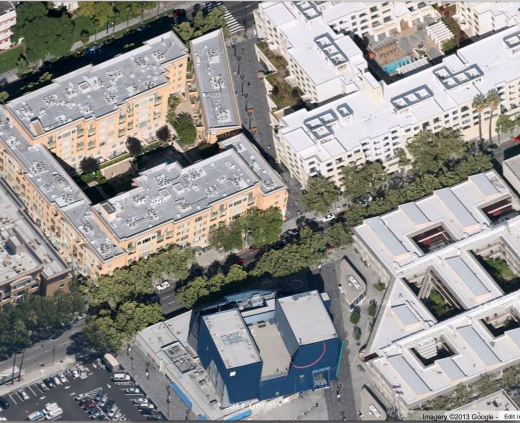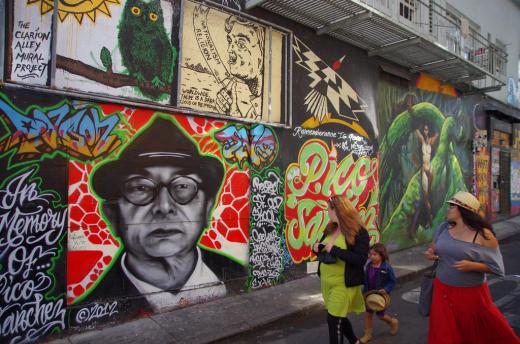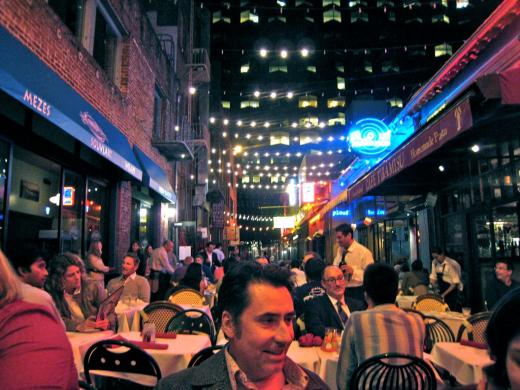Starting May 20, SPUR embarks on a week-long experiment in public placemaking in San Francisco. Working with the Yerba Buena Community Benefit District, we will close Annie Alley to car traffic in order to host a series of outdoor public events, including a picnic, a film screening, a concert and a discussion of the role Zuccotti Park played in Occupy Wall Street.
What is it about an alley that inspires urban invention? As we kick off our week of investigation, we pause to reflect on the humble alley and its role in the city.
The Backstory on Back Alleys
Most alleys had simple utilitarian origins as ways to access buildings with goods and vehicles — especially where a socially decorous street frontage was desired. Commercial blocks in older American cities are often bisected by alleys. In Los Angeles, many retail streets have alleys for service and parking immediately behind the stores, with larger residential blocks behind. Residential alleys serve townhouse districts in Boston’s Back Bay and much of Washington, D.C., (but not New York). In Venice Beach, alleys make canals and “walk-streets” possible.
Beijing’s hutong and Shanghai’s longtang alleys are the basis of the traditional residential fabric. These narrow lanes host a rich mixture of local functions, including access to the modular courtyard houses they serve. The explosive growth of Chinese cities has made these districts and their way of life something of an endangered species despite belated efforts at preservation.

A traditional hutong in Beijing. Image courtesy flickr user tsc_traveler.
What Alleys Offer
Access
Alleys are the capillaries of the city’s circulation system — the smallest unit, where movement is the slowest and exchange the highest. Beyond the utility of loading, parking and rear access, alleys subdivide blocks into shorter segments, providing shortcuts and frequent route choices. In San Jose, the Paseo de San Antonio allows pedestrians to cut through blocks that would be 800 feet long, and in San Francisco, alleys allow pedestrians to navigate the outsized blocks South of Market. The finer grain of circulation provided by these small streets is one of the hallmarks of a walkable city.

In San Jose, the pedestrian-only Paseo de San Antonio cuts a diagonal line through several large city blocks, improving walkability downtown. Image courtesy Google Maps.
Sin
Often as not, alleys have been associated with fear, criminal activity, speakeasies, forbidden pleasures and creeping dangers. Hidden from view, away from the city’s more presentable facades, alleys offered fertile terrain for underground culture, marginalized groups and unsanctioned behavior. In the 19th century, the alleys of San Francisco’s Chinatown hosted bordellos, opium dens and gambling parlors, all luridly chronicled in the anglo press. A century later, San Francisco’s gay leather scene thrived in the alleys south of Market, as did punk and electronic dance music. The back alleys of the city offer openings into the back alleys of our culture, charged with both the allure and the dread we project on unknown urban quarters.
Art
Alleys have also provided a ready canvas for street art, from Chicano muralismo andhip-hop bombing to wheatpasting and stenciling. Assertions of identity and resistance mix with personal visions, wit, and out-and-out vandalism, each defined in the eye of the beholder. Spots like Balmy and Clarion alleys, which started as handy surfaces away from prying eyes, have become urban galleries, first tolerated and then cherished as each layer of expression has drawn more in turn.

Murals on Clarion Alley in San Francisco's Mission District. Photo courtesy flickr user neeravbhatt.
Scale
Urban designers are preoccupied with “spatial enclosure” — the way spaces are given three-dimensional shape by the surrounding buildings, creating urban “rooms.” Suburbs have almost no enclosure, while the gothic quarter of Barcelona is its apotheosis. Alleys are one of the few reliable sources of enclosure in American cities. Where wide thoroughfares are the norm, these kinds of spaces provide the exception, a source of relief from the prevailing pattern, another stratum to explore. Some of the city’s keenest pleasures are offered by the transitions in scale — from the thrum of the grand boulevard to the quiet of the back streets. Nowhere is this more true than South of Market, where Jasper O’Farrell, the city’s first surveyor, laid out a tract of 100-vara lots — four times the size of the lots north of Market. Today these blocks sit among streets dominated by auto traffic. Here, alleys provide the saving grace, a human-scale refuge and an alternative network for the savvy pedestrian. Some have been choked off and built over, others artfully revitalized. But most remain just as they were: narrow, forgotten spaces, inviting exploration and reimagination.
Gathering
The enclosure and intimate scale of alleys shines when they are repurposed as gathering spaces, creating urban rooms that spring to life when filled with diners and revelers. Claude and Belden lanes, packed wall-to-wall with restaurant seating under festive lights, are the most celebrated San Francisco examples. Mint Plaza takes the idea far enough that it’s easy to forget the seedy alley it supplanted. Berkeley’s Trumpetvine Court and Stone Street in lower Manhattan are two more, but nearly every good city has a handful.

Restaurants activate the urban room of San Francisco's Belden Lane. Photo courtesy flcikr user Lynn Friedman.
At their best, alleys can combine nearly all of these functions, becoming containers for the particular magic of city life: discovery, creative expression, memorable spaces and life lived and celebrated out and about, in one another’s company.
Attend our Annie Alley events:
SF’s Long Range Transportation Plan, May 21 >>
Beyond Zuccotti Park, May 21 >>
Film Screening: TINY, a Story About Living Small, May 22 >>
Concert: Curt Yagi & the People Standing Behind Me, May 23 >>
